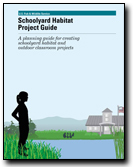
Photo: USFWS
Schoolyard Habitat Program
 The Schoolyard Habitat Program helps teachers and students create wildlife habitat at their own schools. Typical projects include: wetlands, meadows, forests and variations based on specific ecoregions.
The Schoolyard Habitat Program helps teachers and students create wildlife habitat at their own schools. Typical projects include: wetlands, meadows, forests and variations based on specific ecoregions.
Many projects are planned through multiple phases and change over time as children from various classes build upon the existing work of past students.
We work with your school to provide:
- technical assistance and project guidance
- teacher training,
- develop written materials
Our goal is to provide technical and organizational assistance to school, so they can create outdoor classrooms that are effective as educational tools in addition to being a sustainable habitat for many years to come.
Please download the following Fact Sheet for more information on the Schoolyard Habitat Program:
Schoolyard Habitat Fact Sheet (.pdf)
benefits of schoolyard habitats
Improved habitat: Schoolyard habitat projects provide habitat for local and migratory wildlife including songbirds, shorebirds, small mammals, reptiles, amphibians, insects and more. In many cases, these habitats also provide a vegetative buffer to nearby streams, helping to reduce pollution reaching these waterways. To be ecologically sound the schoolyard habitats must be large enough in size and scope so they have a lasting impact on the local environment.
Integrated into the curriculum: Schoolyard habitats offer teaching and learning opportunities in English, science, mathematics, history, geography, social studies and art. The very process of planning, creating and using a schoolyard habitat provides children with unique hands-on experiences. A well-designed schoolyard habitat provides the opportunity for long-term data collection, which teachers attest is an important element for effective teaching.
Stewardship: Research has shown that during the formative years of life, students develop perceptions and values about their environment. If well designed and managed by students, schoolyards can provide them with a powerful example of good land stewardship. Experts have demonstrated that young children are driven to explore, discover and play while refining motor skills. A schoolyard that includes a diversity of natural areas allows students to exercise these needs while nurturing the development of a land ethic that values natural spaces.
Restoring a native habitat on a school site provides opportunities for:
-- Children to develop knowledge and skills as they undertake an exciting, real-life project.-- Teachers to enliven teaching and learning that can weave through the curriculum from kindergarten through 12th grade and beyond.
-- A school to create opportunities for community involvement and diversify the schoolyard environment.
Restoring a school landscape provides the opportunity to engage students in:
-- Scientific inquiry in a meaningful context
-- Hands-on, minds-on learning
-- Real-life, important decisions building confidence and resiliency
-- Interdisciplinary learning in a broad context
-- Work among peers, classes, grades and schools.
Schoolyard Habitat Locations
Schoolyard habitat projects are primarily built on school property. However, as long as the location is accessible to students on a daily basis, projects may be built nearby on private or Tribal lands; in a community park; refuge; or on corporate lands.
Getting Started
The first step to creating a successful Schoolyard Habitat Project is to create a team that includes students, teachers, parents, administrators and community members who will support the project. This team will ensure the project is created with full participation of the school, and will create the foundation of support the school needs for sustainability.
Connecting people with nature is one of the Fish and Wildlife Service’s top priorities. The Schoolyard Habitat program is one of the many ways the Service is achieving this priority. Specific funding has been set aside to complete projects with schools. Funding can be used for:
-- Habitat Restoration: habitat restoration projects on school grounds for use as living laboratories and a natural environment for plants and animals;
-- Outreach and Education: training classroom teachers to develop, implement and maintain conservation projects at schools; and
-- Collaborative schoolyard habitat conservation planning and training in cooperation with communitybased groups.
Schools or organizations serving kindergarten through 12th grade students are eligible for funding and may receive up to $8,000 for their projects. They must be working cooperatively with the U.S. Fish and Wildlife Service to be eligible for funding consideration. Learn more information about the children and nature movement is available from the Children and Nature Network’s website at www.childrenandnature.org.
program coordinator
For more information about the Schoolyard Habitat Program in California, Nevada and Klamath Basin, contact:
Carolyn Kolstad
Schoolyard Habitat Program Coordinator
2800 Cottage Way Suite 2606
Sacramento, CA 95825
916-978-6158
Email: Carolyn_kolstad@fws.gov
Local contacts
Klamath Falls
|
Sacramento
|
|---|




